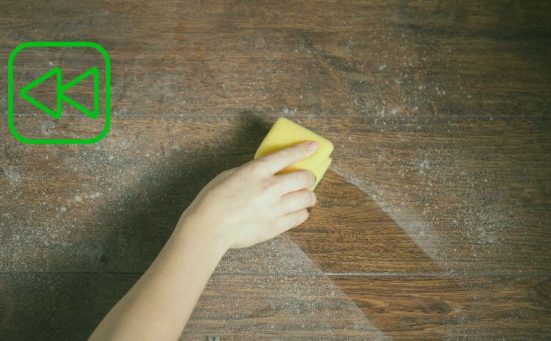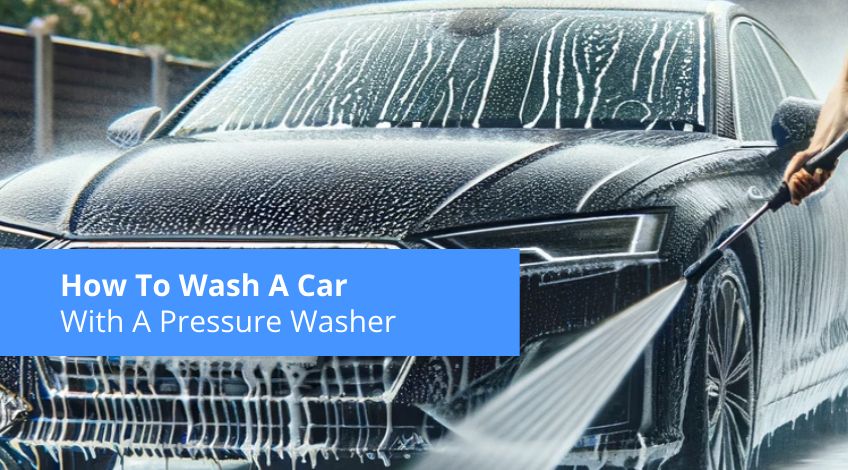
How To Wash A Car With A Pressure Washer (& avoid common mistakes)
Washing a car with a pressure washer is a quick, efficient, and enjoyable way to keep your vehicle looking pristine. The method we’re about to share, done right, can significantly reduce the cleaning time while ensuring thoroughness.
Pressure washers are not only fast but also eco-friendly, saving water and minimising the risk of paint damage, unlike some traditional cleaning methods. In this article, we’ll guide you through the steps to effectively and safely use a pressure washer for your car, highlighting essential techniques and precautions.
By the end, you’ll know how to achieve a sparkling clean car with minimal effort and time, keep reading to learn how.
Key Takeaways
- Use a pressure washer with a green or white nozzle for initial rinsing, maintaining a minimum distance of 12 inches from the car to prevent paint damage.
- Apply car-specific detergent using the black nozzle, and allow it to work for 5-10 minutes, ensuring it doesn’t dry on the car.
- After detergent application, rinse the car starting from the top with the white nozzle, keeping a distance of 3-4 feet to remove all detergent.
- Dry the car thoroughly with a chamois leather to avoid streaks or spots, ensuring all moisture is removed.
- For safety, use a Residual Current Device (RCD) with extension cables, wear protective gear, and avoid washing the car on gravel surfaces.
- Select a pressure washer with the appropriate PSI (up to 1900) and GPM, and choose nozzles carefully to avoid damaging the car’s paint.
- Always consult the manufacturer’s manual for specific instructions on detergent use and pressure washer settings.
Guide To Washing A Car With A Pressure Washer
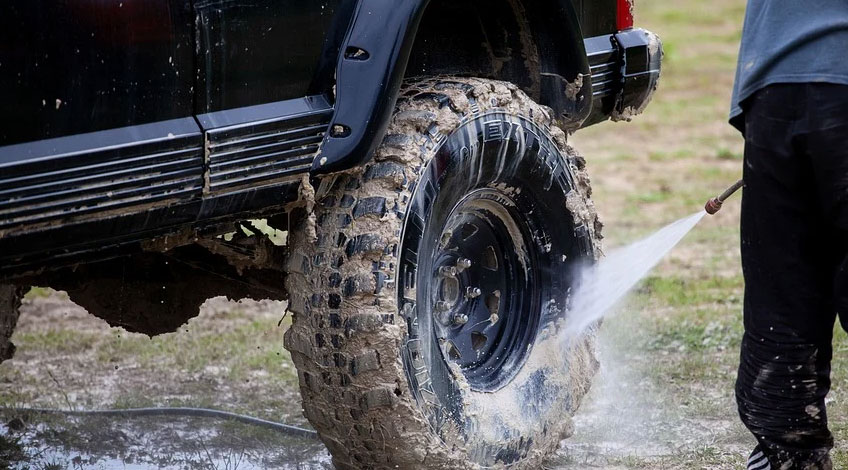
Here’s the step by step guide on how to clean your car correctly and safely using a pressure washer.
Safety Reminder
If you are using an extension cable never use one that’s longer than 10 metres (30 ft) and use a Residual Current Device (RCD) for electrical safety cut out. It’s probably best to wear goggles to protect your eyes and gloves in case you are allergic to anything in the detergent (if using).
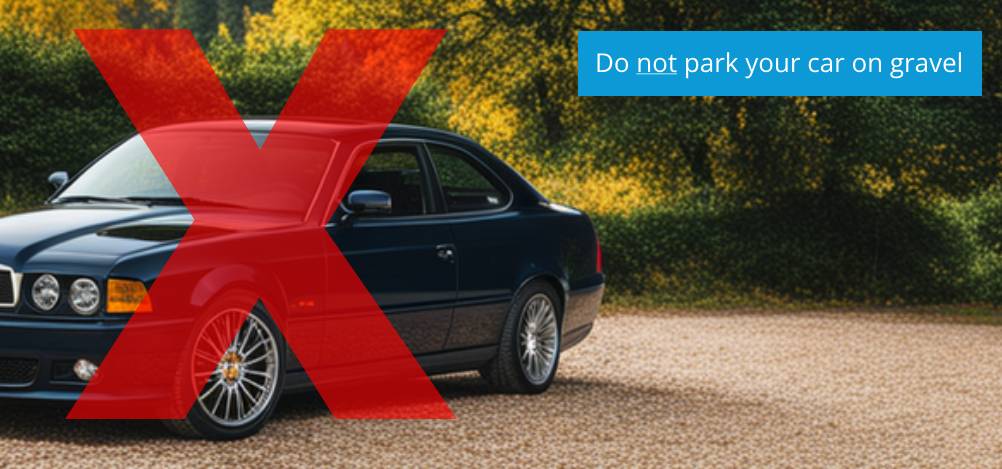
We also recommend not parking your car on gravel when you do this as stones could ping up and scratch your paintwork. Instead, park your car on concrete.
SEE ALSO: Pressure Washer Safety
#1 Rinse The Car
To remove any loose dirt or debris start with a rinse using either the green (25 degree) or the white (40 degree) nozzle. Never use anything lower than that, as using the yellow or red nozzle will probably damage the paint work.
Before spraying the car, spray the jet washer onto the ground, to make sure it is the correct pressure.
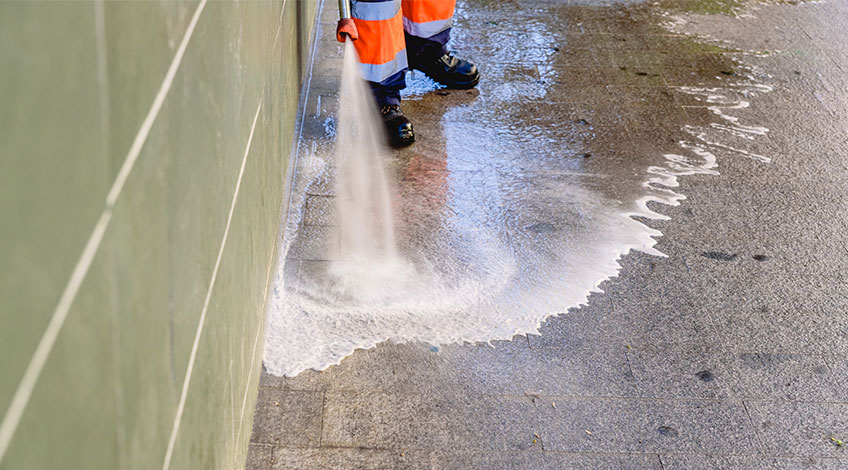
When spraying, ensure the nozzle remains at least 12 inches (30 cms) away from the car.
Spray the entire car including the wheels.
Take care around mirrors, and lights etc. as these can be delicate and easily damaged. So it’s best to take a few steps backwards to lower the pressure when rinsing these areas.
Always angle the spray in a downward direction and avoid spraying directly head on as this might damage the car.
#2 Add Detergent
Always use a detergent that is suitable for the job, catering to both the car and the pressure washer. Most pressure washers have a container for detergent to make it easier to apply. If yours doesn’t apply detergent by hand.
Manufacturers have different ways of using detergents so consult your manual before starting
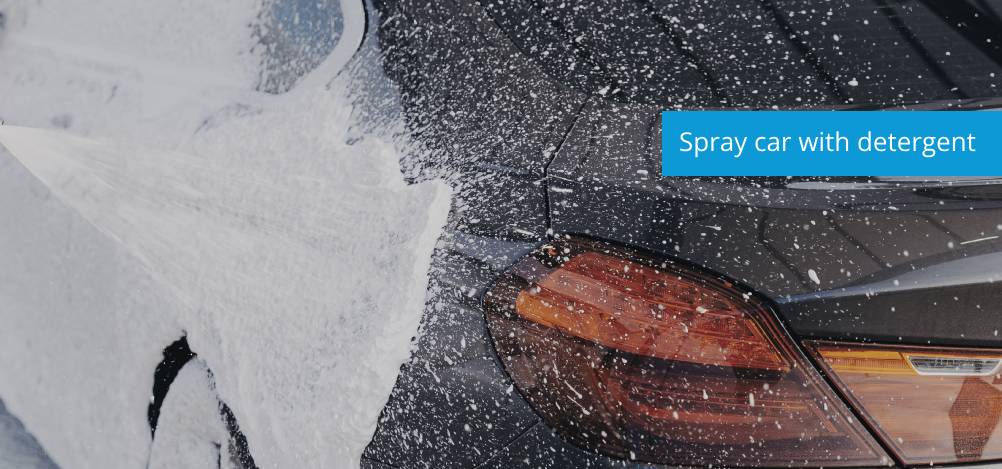
Use the black (65 degree) nozzle to apply detergent (many pressure washers will not use the detergent unless using the black nozzle).
Start spraying with the nozzle around 3 feet (90cms) away from the car, you can move in slightly closer to remove particularly hard stains or squashed insects.
To avoid streaking apply detergents from the bottom and work upwards.
You might have to get closer to thoroughly clean the wheels and wheel arches.
#3 Give The Detergent Time To Work
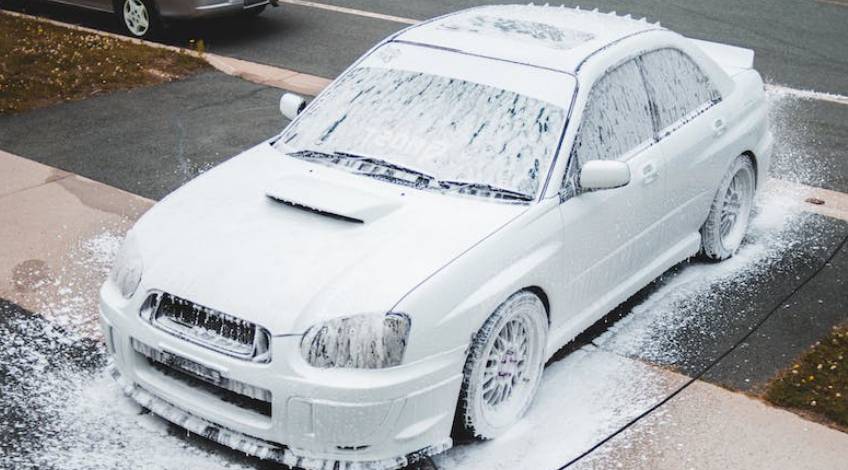
Check manufacturers instructions, but detergents generally need to be left on the car for around 5-10 minutes
Don’t allow the soap to dry out on the car, this might mean intermittent spraying to prevent drying during the 5-10 minute soaking time.
If It’s particularly windy, or a very hot day, it’s more likely that the soap suds will dry out, even in such a short time span.
#4 Get Rinsing
After the soap suds have had time to do their magic, remove the black nozzle, and replace with the white (40 degree) nozzle.
Aim at the floor away from the car and spray, to remove all detergents from the system.
Then rinse the car starting at the top and work downwards.
Keep the nozzle around 3-4 feet (90-120 cms) from the car.
PRO TIP: Make sure you rinse off all the detergent to ensure none of it drys on the car. If detergent drys on your car it’ll leave blemishes that are difficult to remove.
#5 Dry The Car
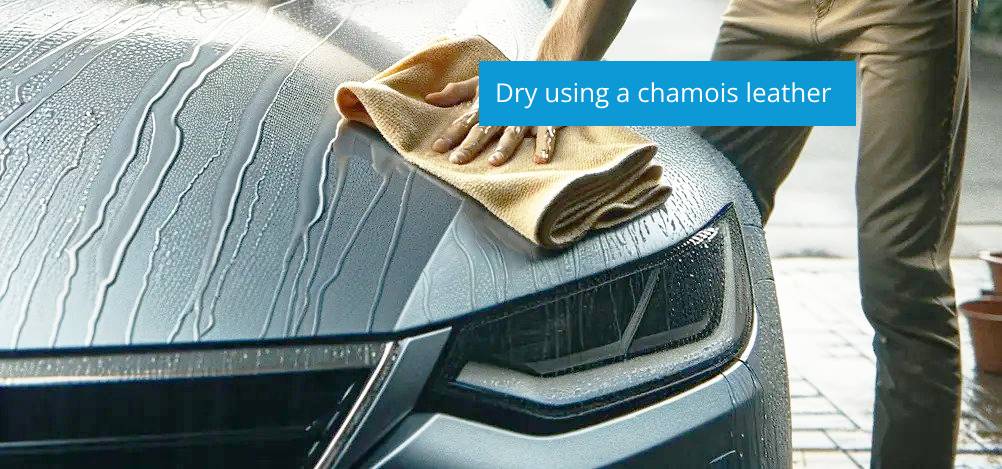
Some people skip this step and let the car air-dry, which is okay. However, to avoid streaks or spots once dry, it’s advisable to use a chamois leather to thoroughly remove all moisture.
Lay the chamois leather flat on the car, pull it towards you, once it’s full of water remove it from the car and wring it out.
Repeat this process until the car is completely dry, then wring out the chamois leather for the final time and allow to dry on a clothesline.
Once it’s completely dry return it to it’s storage pouch for next time.
Pack the pressure washer away after removing all the water and store in a frost free place.
That’s it, the car is clean and dry and ready for you to do whatever you want to do with it. I’m guessing it’s taken as long, if not longer to read this as it will to actually pressure wash your car.
How To Pressure Wash A Car Safely
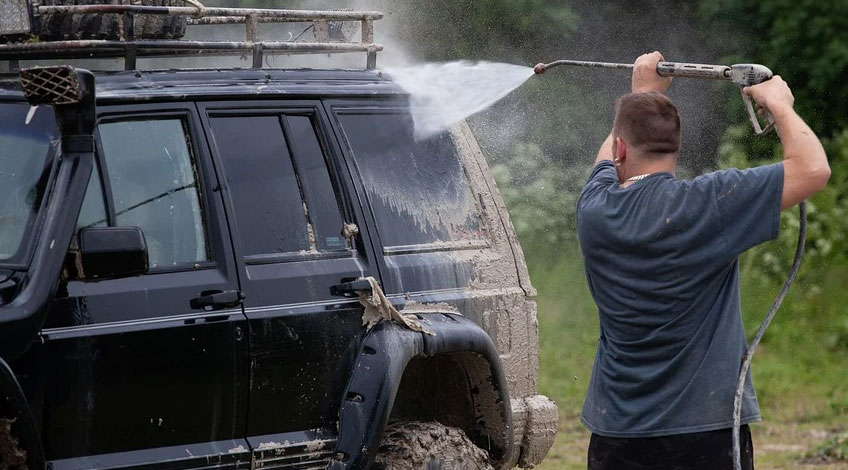
There’s a right way and a wrong way to pressure wash your car, so let’s look at how to do it right.
Safety First
Before we start let’s have a quick look at safety issues you need to take into account.
Electricity
When using a pressure washer, ensure it is close to an electrical socket and avoid using extension cables, as they can invalidate the warranty unless paired with the correct power breaker. So park as close as you can to the power source, allowing for water spillage, remember electrics and water do not mix well.
Clothing
Pressure washers produce a lot of spray. To avoid getting wet, wear a waterproof jacket. Welly boots are a good option too. Avoid open-toed sandals and opt for closed shoes or trainers for better protection.
Pressure Washer PSI And GPM
A pressure washer works by combining water flow (GPM) and water pressure (PSI) to clean dirt and debris. The flow is measured in Gallons Per Minute and the average pressure washer has a GPM of 2. The pressure is measured in Pounds Per Square Inch.
The maximum PSi you should use on a car is 1900 PSI, this will stop you damaging the paint work.
Select The Correct Nozzle
- Compatible with Wilks-USA/ P1/ Hyundai/RocwooD and most other brands Petrol Pressure washer
- Compatible with electric pressure washer with 1/4" quick connection gun or adapter
Most pressure washers are sold complete with a number of different nozzles for different jobs.
Each nozzle is classified with a different colour and they have different uses.
Red Nozzle
The red nozzle produces the most powerful jet of water. So powerful in fact that it can cut clean through wood, and paint. It is also powerful enough to scratch paintwork. Definitely not one to use on the car.
Yellow Nozzle
The yellow nozzle has a 15 degree tip and is used for removing tough dirt. It has less power than the red tip and can be used on many surfaces, including, concrete, drains, roofs, and garage floors.
Green Nozzle
The green nozzle has a 25 degree tip and is mostly used for decks, patios, boats, and cars. It has a wide enough jet spray to clear leaves, yet gentle enough to be used on cars without damaging them.
White Nozzle
The white nozzle is the gentle option and has a wide spraying pattern. Giving maximum spray at low pressure and is definitely suitable for cleaning the car. In fact it’s probably best suited for car cleaning as long as the car isn’t too dirty. We advise starting with the white nozzle and if the dirt doesn’t shift then go up to the green nozzle.
Black Nozzle
The black nozzle has a 65 degree tip which is too soft for cleaning, and is usually used for prewashing, and applying detergent. Then you have to change the nozzle for rinsing properly
The chart below gives the values and uses for the most common nozzles.
| Colour | Degree | Use |
|---|---|---|
| Red | 0 | High pressure, cement and hard surface washer |
| Yellow | 15 | Removes dirt and strips paint from walls |
| Green | 25 | Good for cleaning hard surfaces like concrete free from debris,can also be used as a prewash and final rinse |
| White | 40 | Ideal for car washing, as it cleans large areas quickly. Great for rinsing detergents away |
| Black | 65 | Low pressure, detergent application |
Why Is It Wrong To Use The Automatic Car Wash?
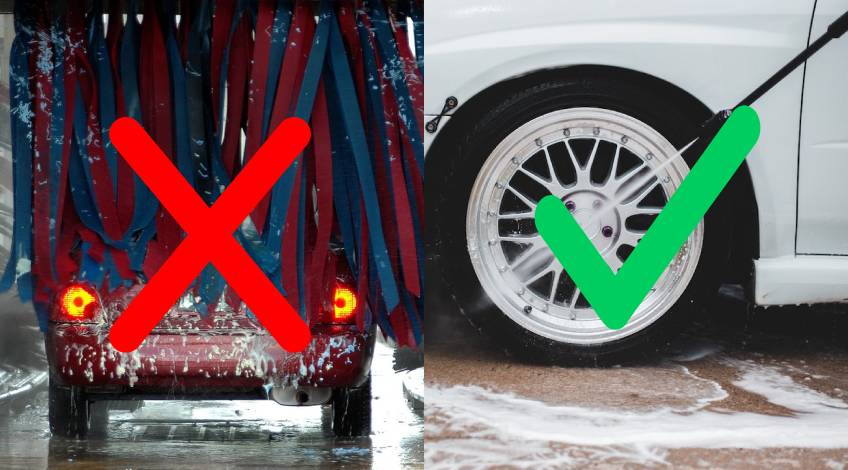
You might be thinking “why not take it to the car wash?” Well firstly it takes petrol to get you there, secondly it costs money, and thirdly automatic car washes can seriously damage your car. The brushes that are used in car washes can easily snap car aerials and wing mirrors, plus you don’t even want to think about what’s actually caught up in those brushes!
From dirt, grit, stones, even tarmac in some cases. Automatic car washes might be easier because all you do is sit there, but how about the work needed to repair the paint work and/or mirrors and arial?
SEE ALSO: What’s Better – Pressure Washer Or Hose To Wash A Car?
Frequently Asked Questions
Cleaning your car with a pressure washer is much easier than using a regular garden hose. This is because the pressure that pressure washers generate make it easy to remove dirt and grime from your car.
No you cannot use just any detergent when washing cars. You have to ensure the one you buy is designed for use on cars. Kärcher and Turtle Wax both do a well respected detergent that many people swear by.
If you’re wondering how to jet wash a car, you’re going to need a reliable pressure washer, some suitable detergent for cars, and a few basic tools. Start by rinsing your car with the pressure washer to remove loose dirt. Next, apply the car-specific detergent using a low-pressure setting. Allow it to soak as per the product’s instructions, then rinse thoroughly with the washer. Finish by drying your car with a clean microfiber towel or chamois to prevent water spots. Remember to use the pressure washer at a safe distance to avoid paint damage.
Also, follow us on Pinterest ...




